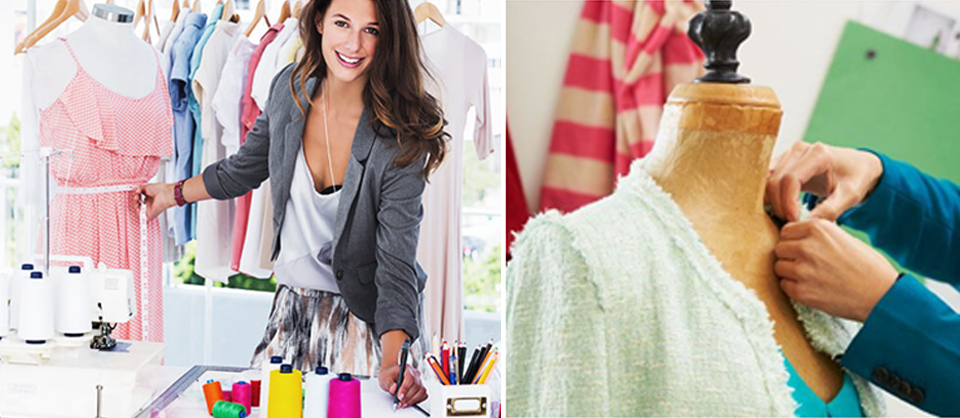
Study with Top Ranked Institute
& Leading Education Group
Admission Helpline
Fashion Courses Inquires: 70871-25200
Beauty Courses Inquires: 7814-301472
Aviation Courses Inquires: 78143-01479

Admission Helpline
Fashion Courses Inquires: 70871-25200
Beauty Courses Inquires: 7814-301472
Aviation Courses Inquires: 78143-01479

The fashion industry is a globalized sector that works to meet the demand for apparel and dictates the trends for what should be worn. This industry consists of five distinct and separate levels. These levels are haute couture, luxury wear, affordable luxury wear, mainstream clothing, and discount clothing.
The fashion industry is a product of the modern age. India’s apparel market will be worth $59.3 billion in 2022, making it the sixth largest in the world, comparable to the United Kingdom’s ($65 billion) and Germany’s ($63.1 billion). “We are moving on toward the ‘gold collar’ worker. It’s a term that defines the well-paid, highly paid professionals, who are happy to look good, happy to feel good, and are expanding the consumption of today.”
Given these dynamics, it is little surprise that more than 300 international fashion brands are expected to open stores in India in the next two years. In short, the Indian market offers great promise. Despite structural challenges that include inequality, infrastructure, and market fragmentation, we expect that strong economic growth, scale, and rising tech savvies will combine to make the country the next big global opportunity in fashion and apparel.
A fashion designer is in charge of creating garments, lines or collections of garments according to the identity and positioning of a brand. Fashion designers have to determine the general orientation of a collection, create color palettes, design the shapes and lines of the garments, imagine details and finishing, choose the right fabrics, follow the prototypes production. Depending of the size and organization of the brand, a fashion designer can work on complete collections or be specialized on a particular type of clothes. Free-lance fashion designers have work for various companies and have to adapt their personal creative skills to them.
A textile designer creates fabrics by choosing materials and yarns and designing weavings and finishing or imagines motifs and patterns with a matching color range to be reproduced on printed fabrics. Creative skills as well as strong technical knowledge of textiles are required.
A pattern maker must be able to convert the designer's idea into a 3-dimensional shape. He or she is the link between design and production. He or she makes sample garments including the technical and practical requirements concerning its construction. He or she must excel in either pattern making or draping and be skilled with computer assisted drafting. The pattern drafter also takes responsibility for production through the fittings, final alterations and collection production follow-up.
A textile buyer manages the supply of various materials used in creating garments. In collaboration with the product manager and fashion designer, he or she places fabric orders necessary for completion of collections and follow the orders delivery. The textile buyer needs good knowledge of fabrics and the technical aspects of production, along with good organization and negotiation skills.
The Head designer is the link between the Art Director and the teams in charge of designing the collections and products. He/she must understand and communicate the Art Director vision and lead the designers to translate it onto real products. Both creative and team management skills are required.
An independent designer is the founder and art director of a new brand. He/she has to design collections according to the positioning and the identity of the brand he/she has created and promote it. An independent designer must have a global vision of his/her brand and must be able to work closely with managers in order to develop the brand according to this vision.
The Art director manages all the creative aspects of a fashion brand. He/she is responsible for the coherence between the products, the image and the identity of a brand. He/she is in charge of various collections (pre-collections, catwalk collections, accessories…etc) and the different ways the products are shown (fashion show, adverts, store concepts, visual merchandising…). The Art director has to mix a very strong creative and visual universe with good communication skills and an analytic approach of brands.
A fashion journalist has to research, find and propose fashion related subjects for articles or reports, write and edit articles, conduct interviews, formulate commentaries for fashion shooting and editorials. Fashion journalist can work for very various media such as magazine, newspaper, website, blog, television…etc. A very good knowledge of the fashion industry as well as networking skills are required.
A Fashion Coordinator's responsibilities are filtering and mediating the diverse needs of the company in order to gain coherence from a style or communication. He or she arrange and supervise the marketing of fashion clothing for manufacturing houses, textile firms and retail stores, promoting garments to the press and public.
The role of a fashion assistant is to lend practical support to a fashion designer or a team of fashion designers. A fashion assistant has to organize and schedule the different steps of a collection realization, such as meeting, suppliers orders, delivery following, fittings…etc, but can also be in charge of the first creative researches for trends or colors and of the shape of boards and portfolios or technical documents.



















































SCO 130-131, 2nd floor, Sector 34 A, 160022 Chandigarh
© 2020 Copyrights. All Rights Reserved.
Designed by AMS Informatics